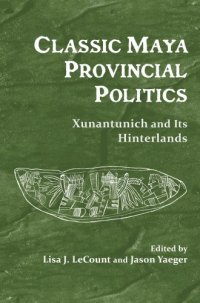
Ebook: Classic Maya Provincial Politics: Xunantunich and Its Hinterlands
Author: Lisa J. LeCount Jason Yaeger
- Tags: Belize, Central America, Americas, History, Guatemala, Central America, Americas, History, Native American, Americas, History, Mayan, Ancient Civilizations, History, Archaeology, Politics & Social Sciences
- Year: 2010
- Publisher: University of Arizona Press
- Language: English
- pdf
Most treatments of large Classic Maya sites such as Caracol and Tikal regard Maya political organization as highly centralized. Because investigations have focused on civic buildings and elite palaces, however, a critical part of the picture of Classic Maya political organization has been missing.
The contributors to this volume chart the rise and fall of the Classic Maya center of Xunantunich, paying special attention to its changing relationships with the communities that comprised its hinterlands. They examine how the changing relationships between Xunantunich and the larger kingdom of Naranjo affected the local population, the location of their farms and houses, and the range of economic and subsistence activities in which both elites and commoners engaged. They also examine the ways common people seized opportunities and met challenges offered by a changing political landscape.
The rich archaeological data in this book show that incorporating subject communities and people—and keeping them incorporated—was an on-going challenge to ancient Maya rulers. Until now, archaeologists have lacked integrated regional data and a fine-grained chronology in which to document short-term shifts in site occupations, subsistence strategies, and other important practices of the daily life of the Maya. This book provides a revised picture of Maya politics—one of different ways of governing and alliance formation among dominant centers, provincial polities, and hinterland communities.
The contributors to this volume chart the rise and fall of the Classic Maya center of Xunantunich, paying special attention to its changing relationships with the communities that comprised its hinterlands. They examine how the changing relationships between Xunantunich and the larger kingdom of Naranjo affected the local population, the location of their farms and houses, and the range of economic and subsistence activities in which both elites and commoners engaged. They also examine the ways common people seized opportunities and met challenges offered by a changing political landscape.
The rich archaeological data in this book show that incorporating subject communities and people—and keeping them incorporated—was an on-going challenge to ancient Maya rulers. Until now, archaeologists have lacked integrated regional data and a fine-grained chronology in which to document short-term shifts in site occupations, subsistence strategies, and other important practices of the daily life of the Maya. This book provides a revised picture of Maya politics—one of different ways of governing and alliance formation among dominant centers, provincial polities, and hinterland communities.
Download the book Classic Maya Provincial Politics: Xunantunich and Its Hinterlands for free or read online
Continue reading on any device:

Last viewed books
Related books
{related-news}
Comments (0)